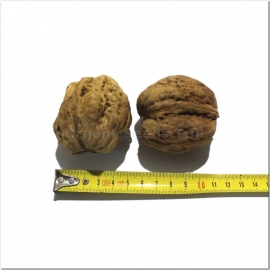








Organic Giant walnut Seeds (Juglans regia)
3.00 €
The fruits themselves are very large nuts, hence the name "Giant". The average weight of dried nuts is 20-25 grams. The shell is thin (shell thickness 1.0 - 1.5 mm). This variety of walnut - refers to the table and decorative varieties.
-
Walnut "Giant"
it is a late ripening variety. The tree of this variety is fast-growing, powerful, with a crown of medium density. The flowering type of the "Giant" variety is homogamous. Fruiting is mainly apical, good and regular over the years. This variety begins to bear fruit in 5-6 years. Very resistant to brown spot and other diseases inherent in walnuts.
The fruits themselves are very large nuts, hence the name "Giant". The average weight of dried nuts is 20-25 grams. The shell is thin (shell thickness 1.0 - 1.5 mm). This variety of walnut - refers to the table and decorative varieties.
It is better to start germinating the nut in early April, in the following way. Put the nut in a glass jar and cover with water (preferably not chlorinated) at room temperature. It is necessary to change the water at the same time, in the morning or in the evening every day for 3 days.
After that, it is necessary to transfer the nut to wet sand for 15 days. The walnut is placed sideways on the edge. For this operation, you can use a flower pot, or a cut 2 liter plastic bottle with holes in the bottom to drain excess liquid. It is necessary to bury the nut to a depth of about 10 cm.
The container in which we place the nut must be kept at room temperature. In 15 days, almost all nuts germinate and immediately begin to give roots, and sometimes they even release shoots. In early May, on holidays, if the weather permits, the sprouted nuts are planted with their roots down, immediately to a permanent place: in special holes, with a depth of 8 to 12 cm.If possible, it is necessary to maintain a distance to neighboring trees - at least 10 m, as well so that the distance from the landing site to the house is at least 3m. It is desirable that the landing site be fertilized in advance, i.e. since autumn, if this has not been done, then fertilization is not necessary after planting.
After planting, the first shoots begin to appear, after 2.5-3.5 weeks and stretch to 10-15 cm by autumn. After the annual growth stops, the trunks begin to get fat.
It is not advisable to water the walnut seedling too much in August, since in this case it can poorly endure wintering and freeze out. If there is a fear that the nut will freeze, then it is better to transfer it to winter in a pot at room temperature. It is necessary to dig out the seedling very carefully together with a clod of earth, without damaging the root system. The next spring, at the onset of warmth, plant the overwintered seedling again in the right place.
It is necessary to start forming the crown of a nut no earlier than 3-4 years of age. The best way to form a crown is to leave three side branches and a central conductor for the future crown, thus forming a walnut bole with a height of about 2 m.
With proper crown formation and good care, nuts begin to bear fruit from the age of 5-6.
Walnut, or voloshsky walnut, is moisture-loving and photophilous. It grows best on moderately moist carbonate loams with a low constant water table. Forms a powerful root system that penetrates deep into the soil. Blooms in April-May; fruits ripen in October-November.
